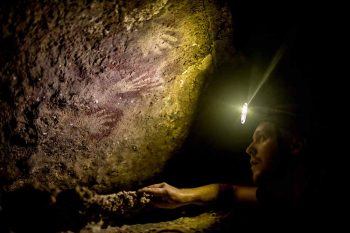From The Chronicle of Higher Education:
 For years, archaeologists thought Europe was the site of the first creative impulses, with famous cave drawings like those at Chauvet, France, putting humans’ innate artistic expression on display. Only in the past decade has that assumption begun to shift, and thanks in large part to the explorations of researchers from the Australian Research Centre for Human Evolution (ARCHE) at Griffith University in Queensland, Australia.
For years, archaeologists thought Europe was the site of the first creative impulses, with famous cave drawings like those at Chauvet, France, putting humans’ innate artistic expression on display. Only in the past decade has that assumption begun to shift, and thanks in large part to the explorations of researchers from the Australian Research Centre for Human Evolution (ARCHE) at Griffith University in Queensland, Australia.
Shortly after completing his Ph.D., Maxime Aubert heard about undated cave art on the Indonesian island of Sulawesi and his curiosity was piqued. Using uranium-series dating, a technique that had not been applied to the paintings before, Aubert — who is now a Professor of archaeological science at Griffith University and researcher both at ARCHE and at the Griffith Centre for Social and Cultural Research — showed that images on the walls and ceilings of the caves had been there for almost 40,000 years, making them at least as ancient as those in Europe, if not even older. The resulting article — published in Nature in 2014 — took the world by storm. Science magazine ranked the research among the top ten discoveries of that year, and noted that it, “could rewrite the history of a key stage in the development of the human mind.” The finding turned the previous theory that human creativity had originated in Europe on its head.
“Essentially they were saying that when humans left Africa they didn’t become collectively modern until they reached Europe — which is not true. We killed that idea,” Aubert says. “It’s more likely that when modern humans left Africa maybe 100,000 years ago they were fully modern.”
More here.
